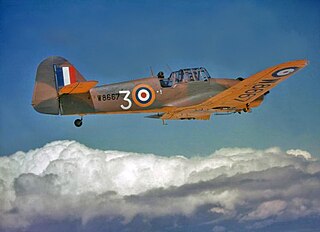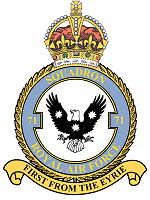British military aircraft designations are used to refer to aircraft types and variants operated by the armed forces of the United Kingdom.

The Sopwith Pup is a British single-seater biplane fighter aircraft built by the Sopwith Aviation Company. It entered service with the Royal Naval Air Service and the Royal Flying Corps in the autumn of 1916. With pleasant flying characteristics and good manoeuvrability, the aircraft proved very successful. The Pup was eventually outclassed by newer German fighters, but it was not completely replaced on the Western Front until the end of 1917. Remaining Pups were relegated to Home Defence and training units. The Pup's docile flying characteristics also made it ideal for use in aircraft carrier deck landing and takeoff experiments and training.

The Miles M.9 Master was a British two-seat monoplane advanced trainer designed and built by aviation company Miles Aircraft Ltd. It was inducted in large numbers into both the Royal Air Force (RAF) and Fleet Air Arm (FAA) during the Second World War.
This is a list of aviation-related events from 1942:
This is a list of aviation-related events from 1914.

This is a list of aviation-related events from 1915:
This is a list of aviation-related events from 1916:
This is a list of aviation-related events from 1917.
This is a list of aviation-related events from 1918:

The Supermarine Walrus was a British single-engine amphibious biplane reconnaissance aircraft designed by R. J. Mitchell and manufactured by Supermarine at Woolston, Southampton.

No. 4 Squadron, normally written as IV Squadron, of the Royal Air Force operates the BAE Hawk T2 in the training role from RAF Valley.

The Sopwith 1+1⁄2 Strutter was a British single- or two-seat multi-role biplane aircraft of the First World War. It was the first British two-seat tractor fighter and the first British aircraft to enter service with a synchronised machine gun. It was given the name 1+1⁄2 Strutter because of the long and short cabane struts that supported the top wing. The type was operated by both British air services and was in widespread but lacklustre service with the French Aéronautique Militaire.

The Sopwith Tabloid and Sopwith Schneider (floatplane) were British biplanes, originally designed as sports aircraft and later adapted for military use. They were among the first successful types to be built by the Sopwith Aviation Company. The "Tabloid", so named because of its small size, caused a sensation when it made its first public appearance.

The Morane-Saulnier L, or Morane-Saulnier Type L, or officially MoS-3, was a French parasol wing one or two-seat scout aeroplane of the First World War. The Type L became one of the first successful fighter aircraft when it was fitted with a single machine gun that fired through the arc of the propeller, which was protected by armoured deflector wedges. Its immediate effectiveness in this role launched an arms race in fighter development, and the Type L was swiftly rendered obsolete. The original Type L used wing warping for lateral control, but a later version designated Type LA was fitted with ailerons.
The history of the Royal Air Force, the air force of the United Kingdom, spans a century of British military aviation.

No. 71 Squadron was a Royal Air Force aircraft squadron. The number has been used three times: once by the Royal Flying Corps for an Australian Flying Corps squadron; in the Second World War as the first of three Eagle Squadrons; and post-war as a fighter-bomber unit under the command of Royal Air Force Germany.

The Nieuport 12 was a French sesquiplane reconnaissance, fighter aircraft and trainer used by France, Russia, Great Britain and the United States during World War I. Later production examples were built as trainers and served widely until the late 1920s.
The Grahame White Type XV was a military trainer biplane produced in the United Kingdom before and during World War I. It is often referred to as the Box-kite, although this name more properly describes the Grahame-White Type XII, an earlier aircraft made by the company, from which the Type XV was derived. It is also known as the Admiralty Type 1600, since the first aircraft of the type purchased for the Royal Naval Air Service was given that serial number, and contemporary practice was to assign type numbers based on the serial number of the first example in service.
Heston Aircraft Company was a British aircraft manufacturer based at Heston Aerodrome, Middlesex, England.














